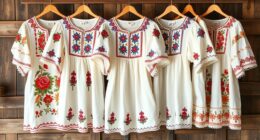Warm tones like red, orange, and yellow boost your mood and emotional well-being at home by creating energizing, cozy, and joyful environments. Red can increase excitement, while orange promotes enthusiasm and socializing. Yellow lifts spirits and evokes happiness. Using these colors intentionally influences your mental state, helping you feel more energized, relaxed, or safe depending on the shade. Keep exploring to discover how to harness these shades for a more positive space.
Key Takeaways
- Warm tones like red, orange, and yellow can elevate energy levels and foster feelings of happiness at home.
- Using warm colors creates inviting, cozy environments that promote comfort and emotional security.
- Orange and yellow stimulate enthusiasm and social interaction, helping to uplift mood and reduce sluggishness.
- Red enhances focus and motivation, making certain spaces more energizing and purposeful.
- Strategic incorporation of warm hues supports emotional well-being and transforms home spaces into mood-boosting environments.

Have you ever wondered how colors can influence your mood and well-being? The answer lies in the fascinating world of color psychology, which explores the psychological effects colors have on your feelings and behaviors. When you choose warm tones for your home, you’re tapping into a powerful tool that can shape your emotional state in subtle yet significant ways. Warm colors like reds, oranges, and yellows are known to evoke feelings of energy, comfort, and enthusiasm. These hues can stimulate your mind, increase your sense of warmth, and even boost your motivation. It’s no coincidence that many homes with lively accents or cozy living spaces feature these vibrant shades—they’re carefully selected to foster a positive atmosphere.
Warm colors like red, orange, and yellow energize, comfort, and boost motivation in your home environment.
In terms of psychological effects, warm tones tend to activate your senses and create a welcoming environment. For example, orange is often associated with enthusiasm and creativity, making it a popular choice for creative spaces or areas where socializing occurs. Yellow, on the other hand, is linked to happiness and optimism, which can uplift your spirits and foster a sense of cheerfulness. Red, the most intense of the warm hues, is known to increase heart rate and generate excitement, making it ideal for spaces where energy and focus are desired. When you incorporate these colors into your home, you’re not just decorating—you’re intentionally influencing your mental state. Additionally, understanding color psychology can help you select shades that support your emotional well-being more effectively.
Using color psychology to select warm tones can also help manage your emotional well-being. If you’re feeling sluggish or down, adding a splash of orange or yellow might invigorate your mood. Conversely, if you want to create a cozy, secure feeling, deep reds and burnt oranges can provide a sense of comfort. The psychology behind these choices isn’t random; it’s rooted in understanding how your mind responds to different visual stimuli. By consciously choosing warm tones, you’re harnessing their psychological effects to promote a more positive and energetic environment at home.
Ultimately, understanding the psychological effects of warm colors allows you to craft spaces that support your mood and mental health. Whether you want to energize your mornings or unwind in a comforting space, selecting the right warm tones can make a noticeable difference. With a little knowledge of color psychology, you can transform your home into a sanctuary that nurtures your emotional well-being, all through the strategic use of color.
Frequently Asked Questions
How Do Warm Tones Influence Sleep Quality?
Warm tones in your sleep environment and bedroom lighting can create a cozy, calming atmosphere that promotes better sleep quality. Soft, warm hues reduce stimulation and help your mind relax before bed. By choosing warm-toned decor and lighting, you make your bedroom a peaceful retreat, making it easier to fall asleep and stay asleep longer. This simple change can markedly improve your overall sleep experience and mood.
Can Color Therapy Replace Traditional Mental Health Treatments?
You might wonder if color therapy can replace traditional mental health treatments, but it’s important to remember that color symbolism and cultural associations influence how you respond to colors. While warm tones can boost your mood, they aren’t substitutes for therapy or medication. Use color therapy as a complementary tool to support your mental health, not as a sole solution. Always consult professionals for serious concerns.
Are There Specific Warm Shades That Boost Productivity?
You’re wondering if specific warm shades can boost productivity. Warm shade selection plays a key role in productivity enhancement by creating an energizing environment. Bright, fiery reds and oranges stimulate enthusiasm and focus, while softer, peach or warm beige tones promote comfort and concentration. By choosing the right warm tones, you can effectively enhance your workspace’s atmosphere, helping you stay motivated and productive throughout your day.
How Long Does It Take to See Mood Changes From Color Therapy?
Imagine a sunrise gradually warming the sky; that’s how your mood shifts with color perception. Usually, you’ll notice emotional responses within a few days to a week as your surroundings influence your feelings. The speed depends on factors like lighting and personal sensitivity. With consistent exposure, warm tones can gently uplift your spirits, creating a more positive environment over time. So, patience and regularity are key to seeing lasting mood changes.
Is Color Therapy Effective for Children and Seniors?
You might wonder if color therapy works for children and seniors. It can positively influence children’s emotional well-being by creating calming or stimulating environments. For seniors, color therapy offers cognitive benefits, helping to maintain mood and mental clarity. While individual results vary, many find that incorporating warm tones can foster emotional balance for children and support cognitive health for seniors, making it a useful complementary approach.
Conclusion
By now, you see how warm tones can truly transform your space and mood. When you choose colors like red, orange, or yellow, you invite energy and comfort into your home. Isn’t it amazing how a simple change in hue can lift your spirits? So, why not start incorporating these warm shades today and create a space that not only looks inviting but also makes you feel good? Your mood and your home will thank you.










